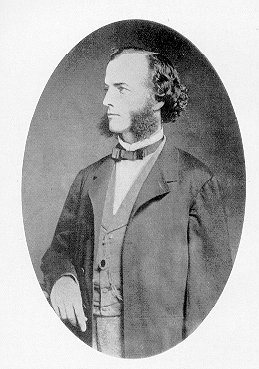Allgemein
Wissenschaftlicher
Apparat zu Kekulés Traum
Rudolf Sponsel & Irmgard Rathsmann-Sponsel -
sgipt@fen.baynet.de
Hauptartikel
Kekulés Traum (vom Hauptartikel aus kann man
sich durchklicken und verweilen wo man möchte)
Über eine typisch-psychoanalytische Entgleisung Alexander
Mitscherlichs über den bedeutenden Naturwissenschaftler und
Chemiker August Kekulé (1829-1896), Mitschöpfer der Valenz-,
Vollender der Strukturtheorie und Entdecker der Bedeutung des
Benzolrings. Alternative Analyse und Deutung aus allgemeiner
und integrativer psychologisch -psychotherapeutischer Sicht.
Ich empfehle, hiermit zu beginnen und sich je nach Lust,
Laune, Interesse hindurchzuklicken.
Durch die Präsentation sonst schwer zugänglicher
Dokumente und Illustrationen können sich Interessierte an der
Erforschung, Diskussion und Kritik zu Kekulés Träumen
beteiligen.
http://www.fen.baynet.de/sgipt/th_schul/pa/kek/kek_ueb.htm
 Kekule
von Stradonitz, (Friedrich) August Kekule
von Stradonitz, (Friedrich) August
b. Sept. 7, 1829, Darmstadt, Hesse
d. July 13, 1896, Bonn
chemist
who laid the groundwork for the modern structural theory in
organic chemistry. Intending to be an architect, he entered
the University of Giessen but came under the influence of
Justus von Liebig and switched to chemistry.
After
receiving his doctorate (1852) he studied at Paris, where he
met Charles-Frédéric Gerhardt, from whose type theory of
organic structure Kekule developed his own ideas. He became a
lecturer at the University of Heidelberg (1856) and professor
of chemistry at Ghent, Belg. (1858). He moved to Bonn in 1865.
His
early training in architecture may have helped him conceive
his structural theories. In 1858 he showed that carbon is
tetravalent and that its atoms can link together to form long
chains. This idea, which opened the way to an understanding of
aliphatic compounds, was announced almost simultaneously, but
independently, by Archibald Scott Couper.
http://www.britannica.com/seo/f/friedrich-august-kekule-von-stradonitz/
Friedrich
August von Kekule
Friedrich August von Kekule had a dream of whirling snakes, of
the structure of benzene - the organic chemical compound made
up of a ring of carbon atoms. He reported the dream in the
following words many years after it took place, in a speech at
a dinner commemorating his discovery.
I turned my
chair to the fire [after having worked on the problem for
some time] and dozed. Again the atoms were gamboling before
my eyes. This time the smaller groups kept modestly to the
background. My mental eye, rendered more acute by repeated
vision of this kind, could not distinguish larger structures,
of manifold conformation; long rows, sometimes more closely
fitted together; all twining and twisting in snakelike
motion. But look! What was that? One of the snakes had
seized hold of its own tail, and the form whirled mockingly
before my eyes. As if by a flash of lighting I awoke... Let
us learn to dream, gentlemen.
Arthur Koestler
(in "The Act of Creation") called this incident
"probably the most important dream in history since
Joseph's seven fat and seven lean cows.
http://www.ozemail.com/~caveman/Creative/Brain/kekule.htm
Friedrich
August KEKULE, later Kekulé von Stradonitz.
Rod Beavon - rod.beavon@westminster.org.uk
Born:
Darmstadt, Germany, 7th September 1829.
Died: Bonn, 13th July 1896.
Kekulé
originally studied architecture, but became interested in
Chemistry when he heard Liebig (of condenser fame) give evidence
in a murder trial. His creative period began with a stay in
London (1854-5) as assistant to J Stenhouse at St
Bartholomew’s Hospital. From 1855-58 he was Privatdozent
(Lecturer) in Heidelberg, where he debated with J F W von Baeyer
(of strain theory), and was then successively professor at Ghent
(1858) and Bonn (1867)
http://www.rod.beavon.clara.net/kekule.htm
FRIEDRICH
AUGUST KEKULÉ:
A SCIENTIST AND DREAMER
Mary E. Rothermich, Nancy Zipprich - lpt@www.woodrow.org
Friedrich August Kekulé was born on September 7, 1829 in
Darmstadt, Germany. His family descended from a Czech line of a
Bohemian noble family. As a youth his hobbies included hiking,
botany, collecting butterflies, and sketching. His friends
remembered that he enjoyed the opportunity to debate, had a
quick wit and was very amiable. He started his schooling at the
Gymnasium in Darmstadt and was a good student with an aptitude
for languages, which eventually led to his ability to speak
French, Italian, and English, as well as his native German. He
also had a talent for drawing and it was his family's intent
that he become an architect. Although he had delicate health as
a youth, he became a robust, healthy adolescent with an interest
in gymnastics by the time he graduated in 1847. He loved dancing
and juggling, and was a talented and entertaining mimic.
http://www.woodrow.org/teachers/ci/1992/Kekule.html
Archibald
Scott Couper
and
August Kekule von Stradonitz
Maryellen Nerz-Stormes
In 1857, Kekule proposed that carbon was tetravalent.
In 1858, Kekule
and Couper, two very imaginative thinkers (remember they did not
have the analytical tools like IR and NMR that we have available
today!!), simultaneously and independently recognized that
carbon atoms can link to each other to form chains. Prior to
this thinking, it was believed that molecules could only have
one central atom. This idea made it much easier to explain the
multitude of organic compounds that were being discovered.
http://www.brynmawr.edu/Acads/Chem/mnerzsto/couper-stradonitz.htm
KEKULE
VON STRADONITZ Friedrich August (1829-1896)
On est redevable à Kekule d’avoir fondé la chimie organique
structurale, c’est-à-dire une théorie qui, dans sa première
formulation, assigne aux atomes des positions dans les molécules
qu’ils composent, en vertu de principes géométriques, sans
mettre en question la nature des forces de liaison
interatomiques. Les vues de Kekule sur l’enchaînement des
atomes de carbone dans les molécules organiques ont contribué
de manière décisive à clore le long débat entre théorie des
types et théorie des radicaux qui partageait les chimistes de
la première moitié du XIXe siècle. Ses
conceptions ont, en outre, validé le caractère opératoire de
la notion de valence, en dépit de son attachement à une définition
trop restrictive du concept ; mais sa conviction que chaque
élément était doté d’une atomicité invariable détermina
sa description structurale et, par voie de conséquence, tout le
devenir de la chimie organique. La théorie du benzène atteste
la fécondité des symbolismes graphiques comme instrument de
connaissance approchée.
http://histoirechimie.multimania.com/Lien/KEKULE.htm
|




